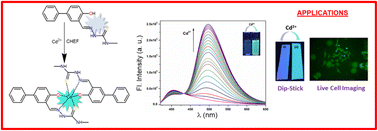A biphenyl thiosemicarbazide based fluorogenic chemosensor for selective recognition of Cd2+: application in cell bioimaging†
Abstract
A diversified biphenyl thiosemicarbazide based chemosensor (HBMC) has been fabricated and reported for the specific detection of Cd2+ in a MeOH : H2O (4 : 1) solution. We observed a chromogenic change from colorless to light yellow colour, and it showed a “turn-on” fluorogenic change from non fluorescent to blooming cyan colour. In fluorometric titration a sharp “turn-on” emission for Cd2+ was observed with a ∼16 fold increase in fluorescence intensity value at 496 nm by incremental addition of Cd2+ ions in the MeOH : H2O (4 : 1) solution. The reversibility of the chemosensor (HBMC) was confirmed by a sequential addition of the EDTA solution. Again the binding stoichiometry of HBMC with Cd2+ was found to be 2 : 1, as confirmed by Job's plot analysis and HRMS spectra of the HBMC–Cd2+ complex. The mechanism for Cd2+ sensing in MeOH : H2O (4 : 1) is based upon the inhibition of C![[double bond, length as m-dash]](https://www.rsc.org/images/entities/char_e001.gif) N isomerization and ESIPT process and simultaneously turning on the CHEF (chelation enhanced fluorescence) process. The limit of detection for Cd2+ was found to be in the order of 10−8 (M), which implies that HBMC is an efficient probe to detect Cd2+ at the microscopic level. A reusability study was performed and on-sight detection of cadmium ions by the chemosensor (HBMC) was established by dip-stick experiment. In vitro detection of Cd2+ in human breast cancer cells (MDA-MB-231) by HBMC discloses its cell permeability and biocompatible nature. Computational studies (DFT and TDDFT) with the probe HBMC and HBMC–Cd2+ complex were also performed.
N isomerization and ESIPT process and simultaneously turning on the CHEF (chelation enhanced fluorescence) process. The limit of detection for Cd2+ was found to be in the order of 10−8 (M), which implies that HBMC is an efficient probe to detect Cd2+ at the microscopic level. A reusability study was performed and on-sight detection of cadmium ions by the chemosensor (HBMC) was established by dip-stick experiment. In vitro detection of Cd2+ in human breast cancer cells (MDA-MB-231) by HBMC discloses its cell permeability and biocompatible nature. Computational studies (DFT and TDDFT) with the probe HBMC and HBMC–Cd2+ complex were also performed.



 Please wait while we load your content...
Please wait while we load your content...